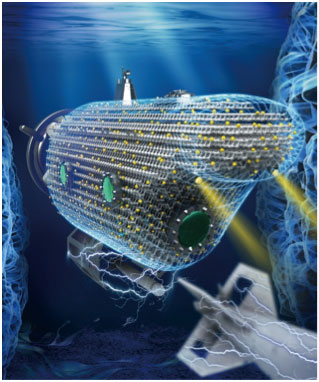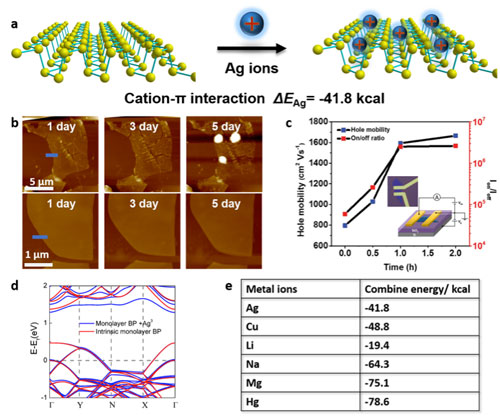| Posted: Mar 07, 2018 | |
The marriage of metal ions and black phosphorus - a new generation of semiconductor transport materials |
|
| (Nanowerk Spotlight) Since 2014, black phosphorus (BP), one of the latest members of two-dimensional (2D) layered semiconductors, has been rediscovered from the perspective of 2D materials for transistors with both high carrier mobility and ON/OFF current ratio. | |
| Different from graphene and transition metal dichalcogenides, BP has a thickness-tunable direct bandgap that spans from a bulk value of 0.3 eV to a monolayer value of ∼2.0 eV in addition to highly anisotropic characteristics and special optical-response properties. | |
| Due to these fascinating properties, BP has demonstrated appealing potential for not only building (opto)electronic devices, but also in many other areas such as lithium-ion batteries, solar cells, sensors, thermoelectric devices, supercapacitors, and phototherapy. | |
| However, a fundamental obstacle hindering the application of BP is its lack of stability under ambient conditions: BP is very reactive to oxygen and water, resulting in rapid degradation of its electronic and optical properties. | |
| A group of researchers from China, led by Professor Han Zhang from Shenzhen University, Professor Xue-Feng Yu from the Chinese Academy of Science, and Professor Lei Liao from Wuhan University, reported a breakthrough in metal-ion-modified black phosphorus with enhanced stability and transistor performance (Advanced Materials, "Metal-Ion-Modified Black Phosphorus with Enhanced Stability and Transistor Performance"): Modifying BP with metal ions solved the former instability problem, which hindered the practical application of BP in electronics and optoelectronics; while at the same time further enhancing the original superior transport properties. | |
| The research team chose silver ions as an example for demonstrating the modification process for metal ions and the obtained enhanced stability and transistor performance. Through cation-π interaction, Ag ions can adsorb on the BP surface spontaneously. | |
 |
|
| Schematic diagram of the spirit of the work. After metal ions have been modified on the surface of BP, they will work as a shield to protect BP and at the same time strengthen the power of the BP on launching the electronic missile. (Image: Shenzhen University) | |
| By conducting density-functional theory (DFT) calculation, the combined energy between silver ions and BP is -41.8 cal, suggesting that the interaction between them is strong enough to obtain stable BPAg(+). | |
| The researchers conducted atomic force microscopy (AFM) to compare the ambient stability of BP and BPAg(+). Based on the surface morphology changes of the BP and BPAg(+), they found that the quality of BPAg(+) is perfectly preserved and no obvious bubbles, corrosion, or degradation can be observed even after 5 days' exposure to air with 95% humidity. | |
| After investigating the transport behavior of silver-ion-modified BP, the team fabricated field-effect transistors (FETs) devices based on BP and BPAg(+). | |
| These Ag+-modified BP FET show greatly enhanced hole mobility from 796 to 1666 cm2 V-1 s-1, that is more than 2 times higher than that of the original bare BP device, and ON/OFF ratio from 5.9 x 104 to 2.6 x 106, which is 44 times the original value. | |
 |
|
| (a) Schematic illustrating adsorption of Ag ions on BP. (b) AFM images of a bared BP sheet exposed to air for (a) 1 day, (b) 3 days, and (c) 5 days. (c) Hole mobility and ON/OFF ratio of the FET device as a function of Ag+ modification time. (d) Simulated band structure of the Ag+-modified monolayer BP with Ef being the Fermi level of the system. (e) Combined energy of commonly used metal ions with BP calculated by DFT with the VASP package. (Image: Shenzhen University) (click on image to enlarge) | |
| Based on the above mentioned detailed investigation of Ag+, the scientists conducted further studies on three metal ions: Mg2+, Fe3+, and Hg2+. | |
| Like Ag+, all three metal ions enhance the stability of BP and the BP sheets after modification are stable for at least 3 days in moist air. | |
| All three metal ions play electron deficient medium roles in the BP FETs. In particular, after modification for 2 hours with Fe3+, the original ambipolar transport behavior of BP changes to a p-type one, probably due to the more positive charges of Fe3+. | |
| Nonetheless, although all three metal ions improve the transport performance of BP FETs, the performance rendered by Ag+ remains the best. | |
| The researchers conclude that such a simple and effective way to enhance both the stability and transistor performance of BP and the stable BP FET will provide black phosphorus with promising potential for electronic and optoelectronic devices. | |
|
Provided by Shenzhen Engineering Laboratory of Phosphorene and Optoelectronics, Shenzhen University, as a Nanowerk exclusive
|
|
|
Become a Spotlight guest author! Join our large and growing group of guest contributors. Have you just published a scientific paper or have other exciting developments to share with the nanotechnology community? Here is how to publish on nanowerk.com. |
|
